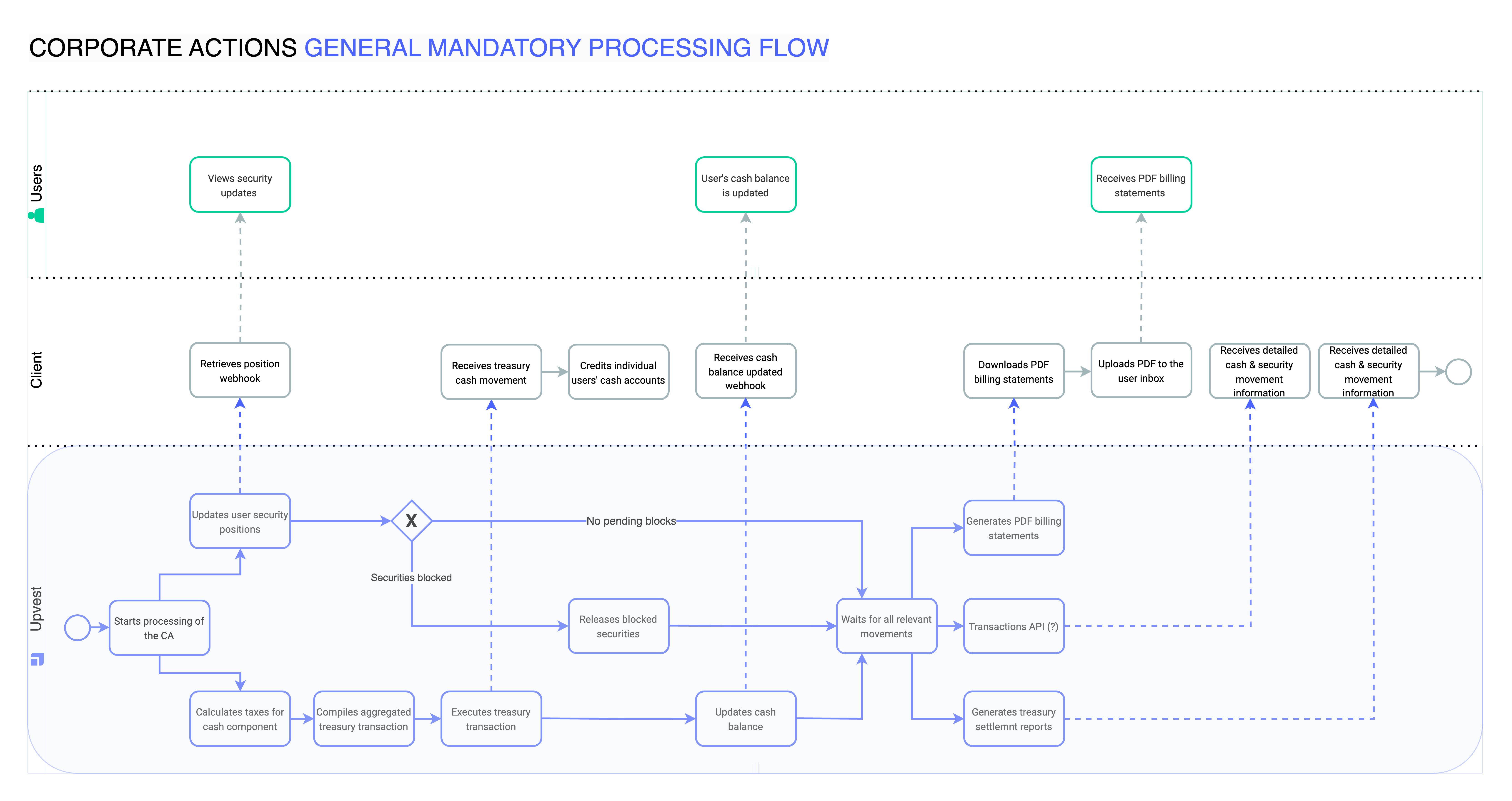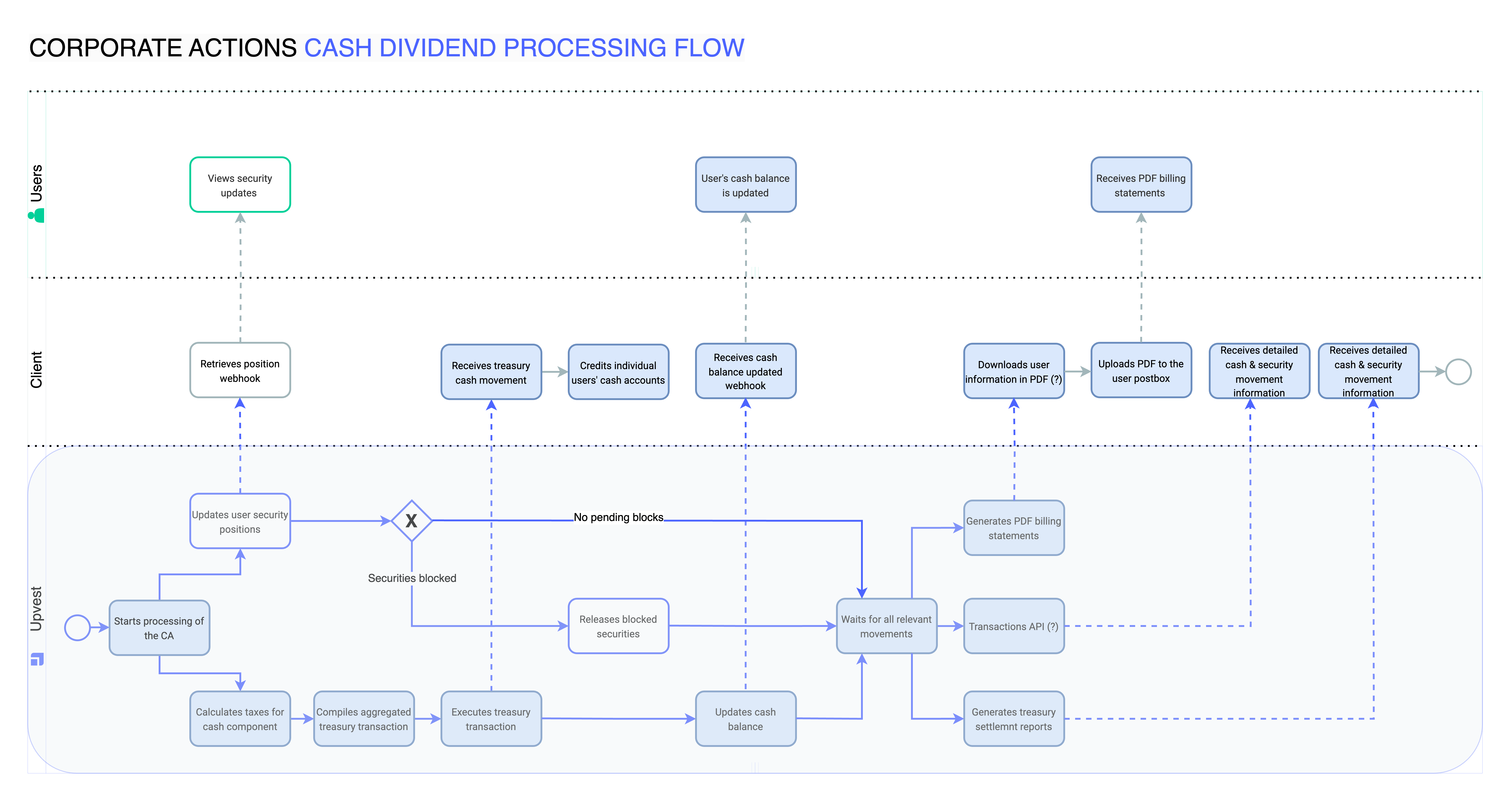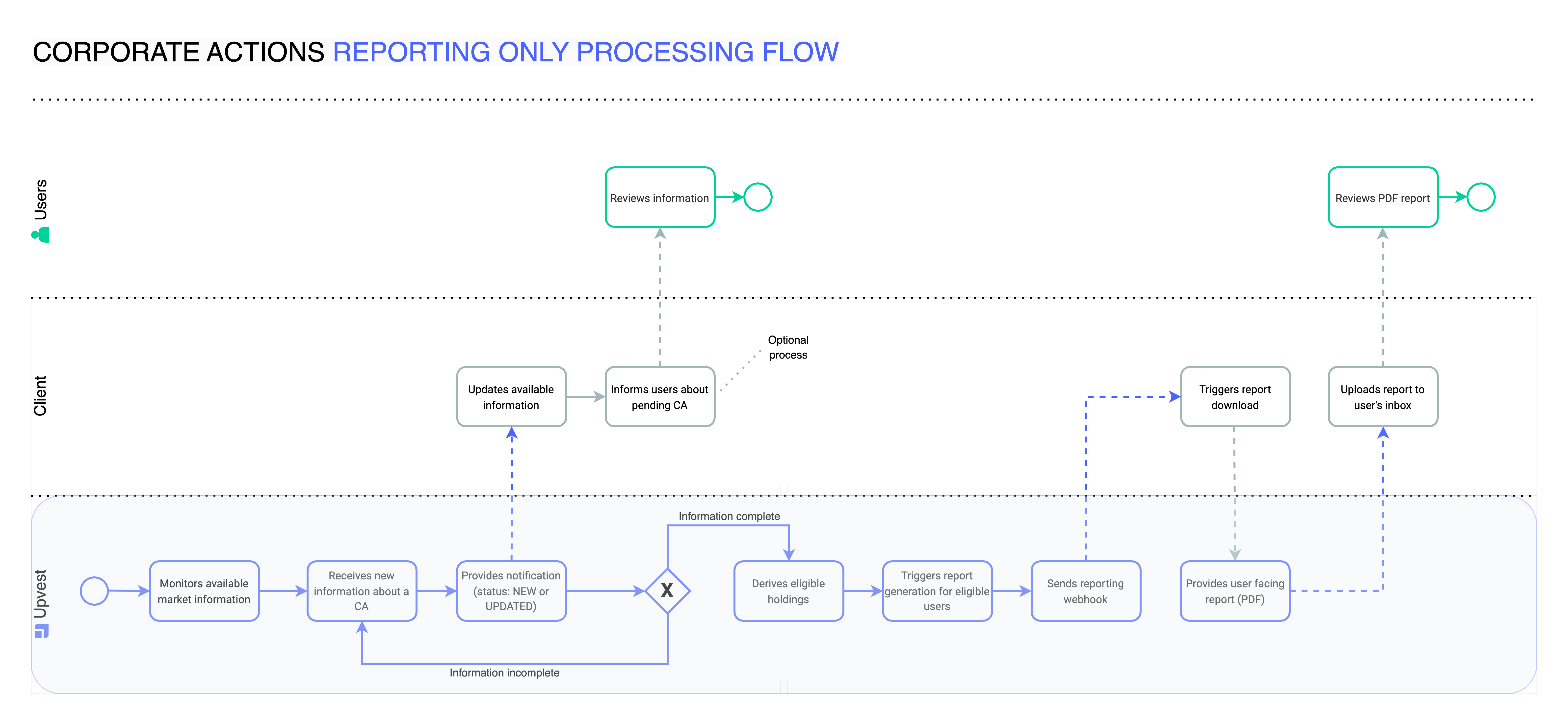Processing corporate actions
This section describes the processing of mandatory corporate actions and what exactly it implies for clients.
Corporate action processing flows
Mandatory corporate actions
The following diagram outlines the entire process for mandatory corporate actions and the points of contact with the client via the Investment API:

Cash dividends corporate actions
In this section you will find a concrete example of the most common corporate action - the cash dividend - and the associated process diagram.
The applicable steps are colored blue. The processing of a cash dividend does not require any blocking of positions (= no blocking of flows).

Reporting-only corporate actions
For reporting-only corporate actions, there are two interactions with the client:
- corporate action announcement (via webhook)
- PDF user report.
An example of a reporting-only corporate action is ‘Place of Incorporation’, which informs end users of a change in the registered office of the underlying company. In this example, the PDF reports provided to the user can be supplemented with official information and/or documents from the issuer of the instrument so that eligible users receive all relevant information about the upcoming changes.
The overall process flow would look as follows:

How does Upvest process corporate actions?
Stock split
If there is a stock split on a security traded by Upvest, users holding that security on the ex-date will see their holding increase by the ratio announced by the company, for example 2:1. They will also see the corresponding decrease in value of each security equal to the original value of their investment.
When this event is announced, Upvest will notify the affected clients via the agreed communication channels. A notification of the event will be placed in the message, including the relevant dates and identification of the users affected. Further details will be provided in the ticket, including:
- list of affected users
- proposed text to be sent to users
- details of processing steps.
In this scenario, Upvest creates an information PDF file that is uploaded to the mailboxes of the users affected by this measure.
Reverse stock split
In the event of a reverse stock split involving a security traded by Upvest, the proportion of users holding that security on the ex-date will be reduced by the ratio announced by the company, e.g. 10:1. They will also see the corresponding increase in value of each security equal to the original value of their investment.
When this event is announced, Upvest will communicate this to the affected clients via the communication channels mentioned above. A notification of the event will be placed in the message, including the relevant dates and tagging of those involved. Further details will be provided in the ticket, including:
- list of affected users
- proposed text to be sent to users
- details of processing steps.
In this scenario, Upvest creates an information PDF file that is uploaded to the mailboxes of the users affected by this measure.
Rights issue
When a company announces a rights issue, the entitled users who hold the share receive rights in their portfolio based on the number of shares they hold and the ratio of the event.
These rights entitle users to purchase new shares at a predetermined price. Investors who elect to purchase additional shares will receive the new shares on the payment date of the subscription offer in exchange for cash deducted from their accounts. For users who do not choose, the ISIN rights will be forfeited and deducted from their account.
As this relates to Upvest, in these cases we will choose the cash option, if available, in accordance with our Terms and Conditions. If not, Upvest will choose the default option.
It is important to note that we do not ask users to make a decision in these cases, but choose on their behalf.
Dividend option
For these event types relating to European shares, an interim ISIN is used for the rights.
The interim ISIN is added to the shareholder's portfolio until the payment date. This ISIN is not tradable.
Once the event has been processed, the user will see this ISIN in their portfolio. The user does not have to do anything here. On the day of payment, the ISIN will be removed and replaced with either cash or securities.
Annual Meeting
According to the Shareholder Rights Directive II SRD-II, investment firms are obliged to offer their users services relating to voting at general meetings.
Upvest offers proxy voting services in co-operation with an external proxy voting provider. To extend proxy voting to your end users, you need to sign a partnership agreement with this provider directly.
The external service provider enables Upvest end users to participate and vote in general meetings. Upvest will upload eligible holdings and other required user information, and the service provider will supply a location to receive users' votes and information. Upvest will not proactively advertise upcoming shareholder meetings.
End users usually receive an email with a link to an upcoming meeting. The link directs them to the meeting agenda where they can cast their vote. The service provider collects all votes and forwards them to our trustee.
Delisting
A delisting occurs when a share is removed from the stock exchange on which it is traded. When this happens and is deactivated by our trading partners, the position is no longer tradable. It remains in the user's portfolio until it becomes tradable again and can be sold, or if a user carries out a portfolio transfer to another broker.
If an ISIN in which no user has an interest is removed from the list by our main trading partners, we will generally inform you of this. No action needs to be taken or communicated to end users.
In the event that there are users who have the ISIN to be delisted in their portfolio, there is a need for action.
As a first step, Upvest will check whether it is possible to offer the ISIN for trading on an alternative or replacement exchange. If this is possible, we will inform the users and give them a time frame within which they must sell.
If this is not possible, we will inform end users as soon as possible and on a best endeavours basis of the impending delisting and the date on which they must sell before the position is no longer tradable on the client platform. When this happens, Upvest will send a notice to clients containing details of the delisting and a table of affected users. The end user also receives a notification with the relevant information.
Merger & acquisition
When two listed companies merge, there is usually a change in investor participation. When a merger is announced, users do not have to take action. These events are usually mandatory, i.e. no options are usually offered.
In most cases, the shares of the companies involved in the merger are combined, with investors in each company receiving a new stake in the combined shares.
This merger is handled by the Upvest Corporate Action Team. The old shares are removed from the portfolio and the new shares are added to the user portfolio after the merger. In most cases, the new shares will have the updated name and a new ISIN. Upvest will inform the client as For Your Information.

